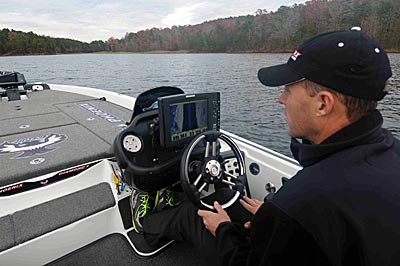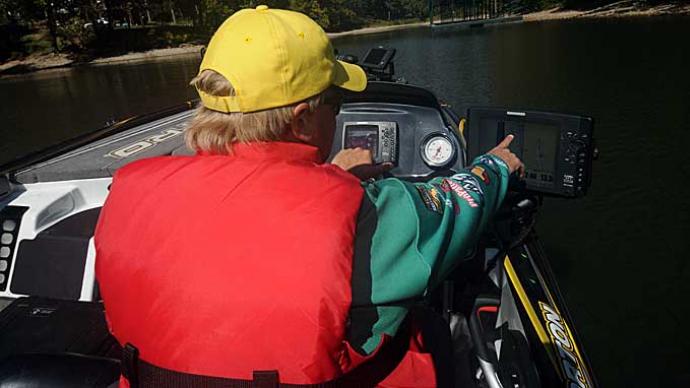
As our reservoirs get older, an excellent bass structure is disappearing.
The touring pros frequently notice the disappearance of creek channels, a prime bass hangout, when they fish reservoirs with a lot of lake levels and water flow fluctuation. Silt depositing into the channels is the cause of the vanishing bass structure.
“You find that everywhere you go,” says Major League Fishing (MLF) pro Aaron Martens. “Some lakes like Georgia and South Carolina lakes are especially silted in.”
Fellow MLF pro Jacob Wheeler frequently notices this vanishing act at Lake Chickamauga, where he sees a bluff bank and thinks there is a channel there with deep water. “I will get over there and find it is only a foot and a half deep,” he says.
When the defined channel is gone, the touring pros know there are still bits and pieces of the channel that hold bass, so they depend on their electronics to find these sweet spots. “A lot of our reservoirs are getting older and older, and as they get more silted in and more debris comes in, now it comes down to a couple of things to find fish,” Wheeler says. “You must pay attention to the stump rows or subtle little places where it drops off a little bit deeper.”
Wheeler scans his electronics to find hard bottom areas where the old channel once was. “If the channel is silted in, I am looking for any leftover hard bottom, stump rows, or with any creek channel that swings into the bank, I am looking for any little hole still there,” Wheeler says. “Even if the channel is silted in, if there is any little rock cropping that comes out and drops down into 3 or 4 foot of water and it is the deepest water there, that is where those fish are going to set up.”
“Just because a lot of the creek is silted in doesn’t mean there isn’t a sweet spot in there,” Wheeler says. “There might be one little place where bass still get on or even a couple of laydown logs in 2 to 3 feet of water.” He suggests any place you can find a hole where the old channel used to be will still be a productive spot.

Wheeler recommends looking at an old paper map or the lake maps on your electronics to get an idea of where the channel was and look for the channel swings. He notes that even if the area is heavily silted, there will be a couple of feet of water in some spots on the old channel, and the fish will either be in those holes or in spots where a straight part of the channel is still intact. Another prime spot to look for is any ditch next to the old channel bend or where an old channel bend intersects with a roadbed, which offers bass a hard bottom structure.
When graphing a silted-in channel, Wheeler relies on the side and down imaging features of his Lowrance HDS12 Carbon unit to find hard bottom areas. He knows the brighter spots on his screen indicate harder bottoms while dark spots show softer bottoms. The Tennessee pro also suggests you can find hard bottoms by looking for double returns with the 2d sonar feature of your electronics.
Martens finds the original channel with the Lakemaster mapping program on his Humminbird Solix unit, and then he will scout the area with the unit’s side and down imaging features. The Alabama pro sets his side imaging to cover both sides of his boat at a range of 200 feet, allowing him to search 400 feet at one time quickly. He also adjusts the contrast and chart speed on his side imaging to get a sharper image. Martens sets his chart speed higher when he is in search mode and running above idle speed. If he wants to inspect an area closer or see fish on the screen, he decreases the distance on his side imaging range, slows his chart speed to 3 or 4, and increases the contrast.
Detecting bright and dark spots on his electronics also helps Martens find the sweet spots on silted-in channels. He knows the brighter spots indicate a harder bottom where current still sweeps across the spot to make a “super clean” channel.
Dark spots on his side imaging can signify a soft bottom or the shadow of a depression or channel bend. “A lot of times, you can tell how deep the creek channel is by the size of the shadow it casts,” Martens says. He can determine whether the dark spot is just siltation or a depression by running over the area and scanning it with down imaging to see if the bottom has a drop or not.
If he cannot find the old channel with side imaging, Martens scouts the area for big rocks that will attract bass. He looks for rocks casting the largest shadows on his side, imaging screen to find the best bass hideouts near the old channel.
Even when siltation erases a major bass attractor, the pros still need to find sweet spots with their electronics to stay ahead of the competition. “We are always looking,” Martens said. “It’s hard to find something off the beaten path anymore.”
A silted-in channel has made the task even more difficult, but not impossible.



